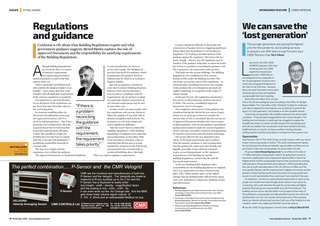




VOICES | HYWEL DAVIES Regulations and guidance Confusion is rife about what Building Regulations require and what government guidance suggests. Hywel Davies explores the role of Approved Documents and the responsibility for satisfying requirements of the Building Regulations A DR HYWEL DAVIES is technical director at CIBSE www.cibse.org lthough Building Regulations are devolved, there is a system of statutory requirements and supporting governmentauthored guidance in each of the four nations of the UK. Those responsible for building work who could be the designer, builder or an installer must ensure that their work complies with all applicable requirements of the relevant regulations or standards. It is important to note that this duty covers all aspects of the regulations, not just those that most obviously relate to the work being done. So, someone installing cables for electrical or broadband provision may use Approved Document (AD) P or AD R for relevant guidance. but if they penetrate a fire compartment, then the requirements of Part B to firestop that penetration appropriately still apply. A boiler flue installed in a high-rise dwelling does not only have to comply with Part J, but also with Regulation 7 prohibiting combustible materials in external walls. The duty is to comply with the regulations, not to follow the guidance. The Approved Documents, or Technical Handbooks in some jurisdictions, are there to advise and to guide. The Building Act provides that proof of compliance which demonstrates the guidance has been followed may be relied on as tending to negative liability. But ADs are guidance, intended to cover more common building situations. However, there may be alternative ways to achieve compliance with the requirements. You do not have to adopt any particular solution contained in an AD; relevant requirements may be met in some other way. In other words, you must comply with the regulations, and you may choose to follow the guidance if you wish. This is all fairly straightforward in theory. Yet, in practice, it is far from simple, and causes significant challenges. Take the recent ban on combustible cladding. Regulation 7 of the Building Regulations in England covers materials and workmanship. In December 2018, it was extended to introduce a ban on materials that did not meet a certain standard for resistance to fire from being incorporated in the external walls of residential buildings above 18m high. This is an explicit regulatory requirement. If there is a problem reconciling the guidance with the requirement, the requirement takes priority 16 November 2020 www.cibsejournal.com CIBSE Nov 2020 pp16-17 Hywel / Patrons.indd 16 23/10/2020 15:40